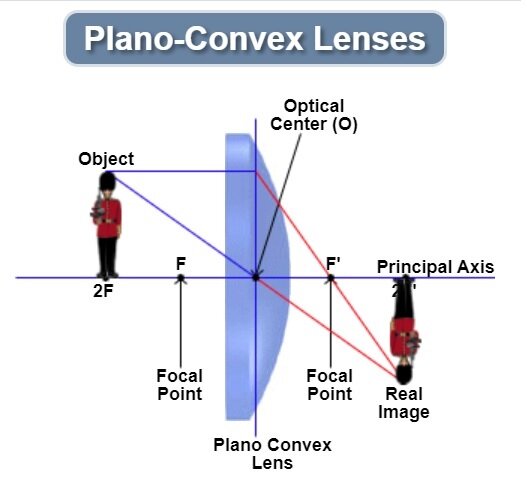Introduction to the Plano-Convex Lens
/the human eye: nature’s plano-convex lens
When it comes time to build an optical system, you’re not going to get very far without familiarizing yourself with the plano-convex lens or singlet spherical lens. Whether it’s an industrial, pharmaceutical, defense or CO2 laser application, the plano-convex lens is essential if light needs to be focused, collected and collimated.
A plano-convex lens is an optical component whose purpose is to focus light into a single point. The “plano” portion refers to one side being flat (a plane) and the “convex” portion refers to the other portion of the lens being bowed outward. A plano-concave lens (a subject for another day) means it is bowed inward or is caved in.
This outward bowing produces what’s called a positive focal length. A positive focal length means that the focal point (or the point where light converges) is on the opposite side of the lens as the object. This means the image will be both inverted and flipped as seen in the below image.
focus, daniel-san
Often anti-reflective or AR coatings are applied when it comes to enhancing these focusing properties of the plano-convex lens. Stray light bouncing around and reflecting off the lens can weaken the strength of the beam that you are trying to focus in the first place. Typical coatings can either be broadband, which means they cover a large wavelength range or targeted for specific wavelengths.
Various Applications for Plano-Convex Lenses
Imaging
Plano-convex lenses are commonplace in imaging devices telescopes, microscopes and binoculars. The asymmetry caused by the one side plano, one side convex lens minimizes spherical aberration in certain applications where the object and image are at unequal distances.
As an object approaches the lens from the plano side, the inverted image grows in size and appears farther away. At double the focal length, the object is still inverted and appears to be the same size on the image side. When an object passes the focal point, the image becomes a virtual image and appears as a magnified version on the same side of the lens as the object.
In short, the plano-convex lens, like all positive lenses, magnifies objects when they are placed between the object and the human eye. These lenses can be built with varying levels of curvature on the lenses and the higher the angle of the lens, the shorter will be the focal length. This is due to light waves refracting at a higher angle with respect to the optical axis of the lens.
Treating farsightedness
Farsightedness or hyperopia is the inability of the eye to focus on objects that are nearby. Distant objects are not an issue but the ability to view nearby object requires a different lens shape, which is not available to the farsighted eye. To view nearby objects a high degree of curvature is needed.
Plano-convex lenses are used in eyeglasses to address this issue, where the distance between the eye’s lens and the retina is short. Thus, the focal point sits behind the retina. Eyeglasses with convex lenses increase the glass’ refraction and reduces the focal length.
The lens, in this case, refracts light before it enters the eye and thus decreases the image distance. By starting the refracting process before the light reaches the eye, the image is able to be brought into focus on the retinal surface.
Either crown glasses or high performance plastics are typically used in this application.
Laser cutting
I like the cut of your jib!
Plano-convex lenses are often chosen for cutting steel or other thick materials via laser. The lens enhances the cut width of the laser, which increases the laser’s ability to penetrate the material. For these types of cutting applications, these lenses provide a greater depth of field which produces a non-tapered edge.
The best materials for this application will have a high damage threshold in order to take the full beating of a focused laser beam.
Common choices for this are ZnSe and germanium. ZnSe has a low absorption and can transmit visible light and a high damage threshold in high power lasers. Germanium, on the other hand, can be used in low power applications and is widely used in the semiconductor industry.
Specs of Plano-Convex Lens
Firebird Optics provides a range of various plano-convex lenses with varying materials, focal lengths, diameters as well as optical coatings. You can check our website for our full and expanding offering of optical lenses. If you don’t find what you need feel free to drop us an e-mail at info@firebirdoptics.com.
Here’s to your success!
Firebird Optics










